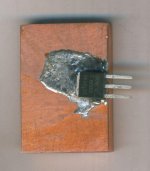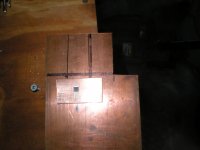When building ZV9 there is a problem: mounting the Power J-FET's
on the heatsink. I have an idea that I would like to share with you. I solder the fets to a copper plate with a hot air gun. Then I throw it in to water allowing it to cool immediately. Then I screw it to the heatsink, with mica insulator. I don't know whether it's working or not but it seems the fet survived the process. I'm waiting for your opinions. Here is a pic:
(More pics and comments soon.)
on the heatsink. I have an idea that I would like to share with you. I solder the fets to a copper plate with a hot air gun. Then I throw it in to water allowing it to cool immediately. Then I screw it to the heatsink, with mica insulator. I don't know whether it's working or not but it seems the fet survived the process. I'm waiting for your opinions. Here is a pic:
(More pics and comments soon.)
Attachments
Thanks for sharing.
Instinctively, I'd skip the immediate cooling to not shock the different metals.
/Hugo
Instinctively, I'd skip the immediate cooling to not shock the different metals.
/Hugo
Netlist, thanks for the reply.
You are right but what about the maximum allowed heat stress ?
(It's 260 °C, over 10 sec.)
Gyuri
You are right but what about the maximum allowed heat stress ?
(It's 260 °C, over 10 sec.)
Gyuri
Gyuri said:Netlist, thanks for the reply.
You are right but what about the maximum allowed heat stress ?
(It's 260 °C, over 10 sec.)
Gyuri
Well, maybe putting it in a shallow water with just the copper partly immersed would help. BTW, a thinner & smaller piece of copper would also do the job nicely and would be easier to adapt to your purposes.
I’d go for the smallest possible copper plate, still allowing you to drill holes for mounting.
Then, tinning that plate and solder the component when the copper is still hot will probably take less then 10 seconds with a good iron. I admit I did not try it but should.
/Hugo
Then, tinning that plate and solder the component when the copper is still hot will probably take less then 10 seconds with a good iron. I admit I did not try it but should.
/Hugo
Netlist was right. Throwing into water is a medieval method. Don't try it ! (Unless you want to see inside the fet.) The fast temperature change will destroy the fet mechanically. Despite this
the idea is good only cooling method was wrong. Next try I put the copper plate with the fet on a wet cloth. It was good.
Gyuri
the idea is good only cooling method was wrong. Next try I put the copper plate with the fet on a wet cloth. It was good.
Gyuri
2 more cents... The copper spreader is a good idea. But, why not just use Arctic Sliver directly to the copper and clamp it on??? The thj of that stuff is absolutely minimal





Thanks for the responce but I was asking about mounting the jfet without soldering
it. Like Nelson posted that he mounts his directly to the heatsink with just thermal
compound relying on the insulating properties of the anodized heatsink. But how does he
hold it on the heatsink?
it. Like Nelson posted that he mounts his directly to the heatsink with just thermal
compound relying on the insulating properties of the anodized heatsink. But how does he
hold it on the heatsink?
use a small copper bar with two holes in it, one hole each side of the fet. use this bar as a clamp when you put screws into the heatsink. i'd draw a picture, cept i think i'm going to fall asleep at my desk.
Didn't Steen(oe) show how to do that some years ago?
RK
Lots of us has shown that.
I know for sure that I have posted pics of such a solution, but ......
I did a search, but came up with nothing. 😕
Magura 🙂
OK, anyway, it should not be that difficult clamping it with a solid aluminium bar. Gonna finish my ZV9 this winter (yes, I will!!!) and will stumble into this. Gonna take a jpeg of my solution... Or should I drop it and get those old Sony VFETs??????????? 😕
use a small copper bar with two holes in it, one hole each side of the fet. use this bar as a clamp when you put screws into the heatsink. i'd draw a picture, cept i think i'm going to fall asleep at my desk.
Too funny.😀😀😀
I just drilled a piece of L-channel aluminum on two sides and mounted to the point it would not move when poked at with a small screwdriver. Easy and cheap. The L acts like a secondary heatsink as well.
A little bit forgot the ZV9, because of F4.
But I picked it out now. The thing works very well, but i'm must finished it.
Do pictures interest somebody possibly?

To avoid misunderstandings not with the weller, but I soldered it with the method written down earlier, avoiding the sudden refrigeration.
Gyuri
But I picked it out now. The thing works very well, but i'm must finished it.
Do pictures interest somebody possibly?
To avoid misunderstandings not with the weller, but I soldered it with the method written down earlier, avoiding the sudden refrigeration.
Gyuri
Last edited:
- Status
- Not open for further replies.
- Home
- Amplifiers
- Pass Labs
- Mounting LU1014D


